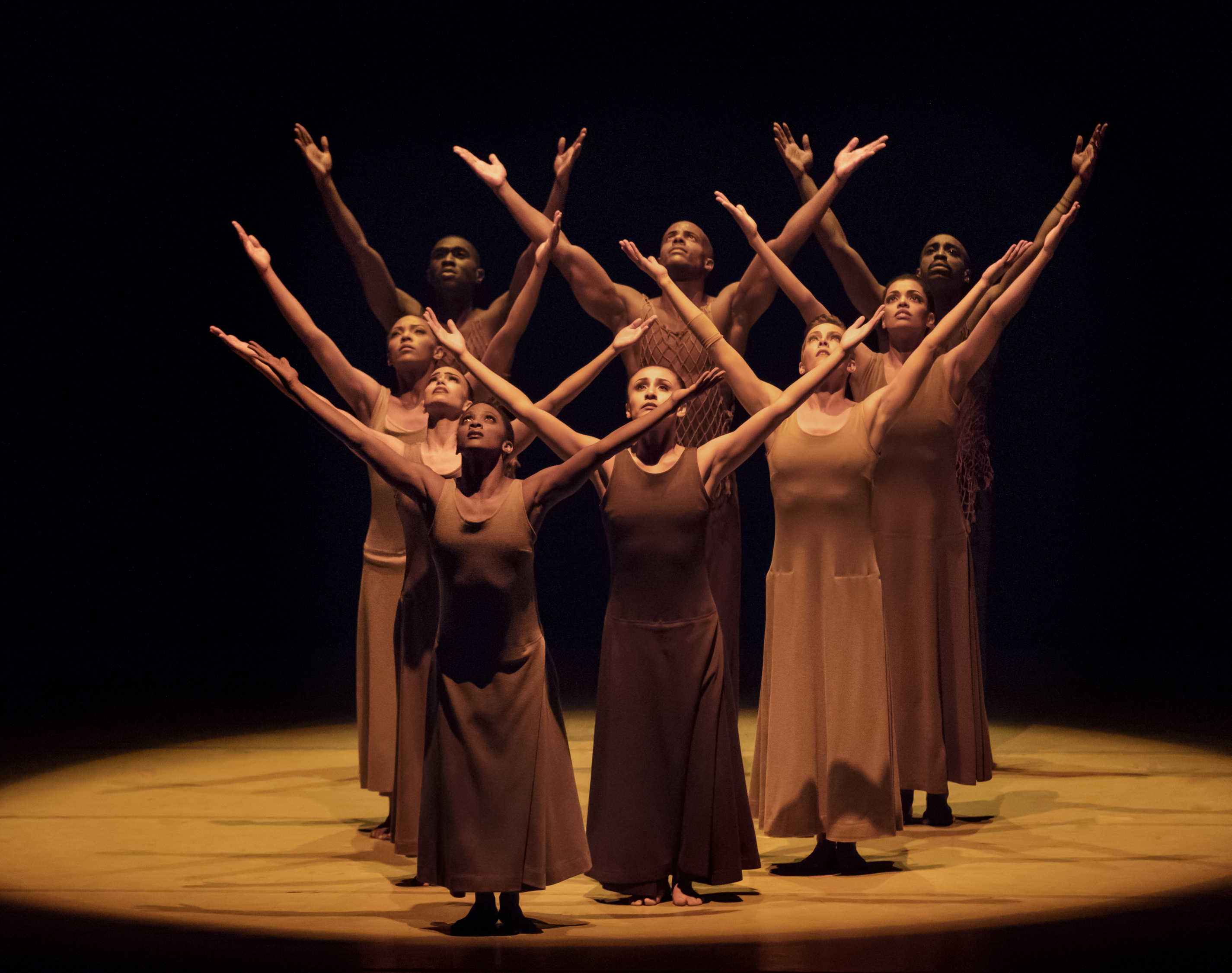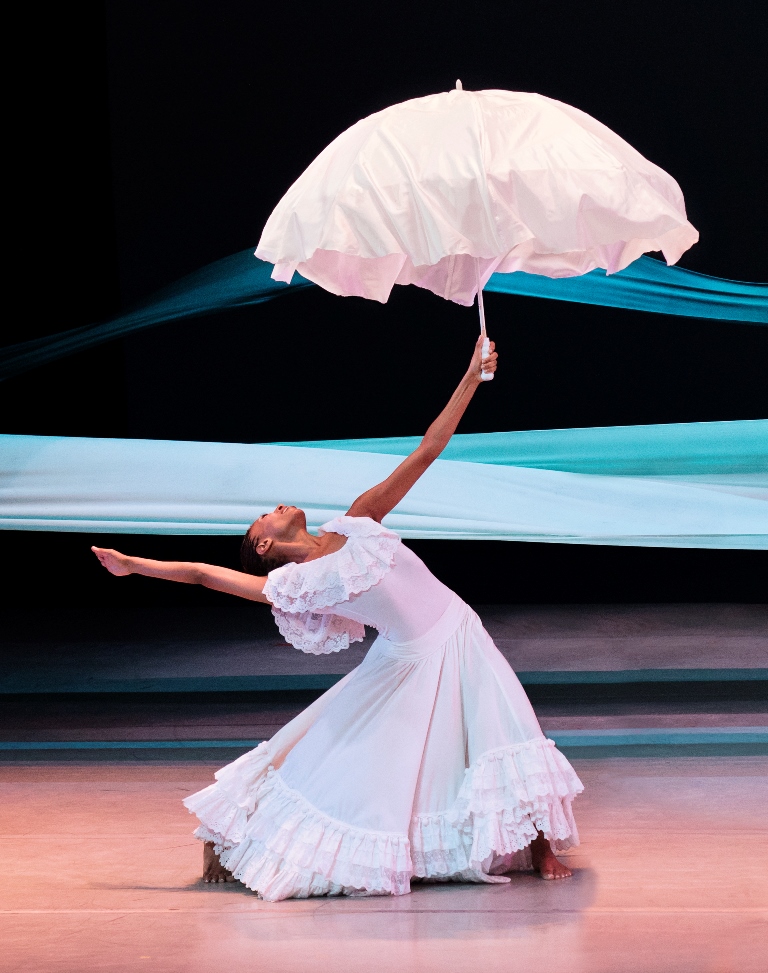Words by Bengi-Sue Sirin and Katie Hagan.
EN
Jessica Lang’s EN included many elements of fate. Jakub Ciupinski’s score captured the character of a casino by using the atmospheric sounds of a roulette-spin and a single pool ball rolling heavily under the table. Choreographically, dancers encounter the same partners throughout the piece, performing slick duets with the person they were fated to meet. Even the costuming enforces Lang’s theme; at one point, the two shirtless men on stage pair with two female dancers in identical clothes, underlining the inevitability of convergence. As I write this, I acknowledge that EN ticks a lot of thematic boxes, but it was slightly without that essence that makes a piece memorable.

The Call
I found The Call to be much more fulfilled. The twenty minute piece is divided into three parts. We see features of Ailey’s technical style at its cross-rhythmic finest in the first section, matched by Yo-Yo Ma’s modern take on a Bach sonata. Strong diagonal lines manifest in both the staging and the body, and there is much gaze-led travelling across the stage. I loved the jazzy middle section, where Ailey’s cultural heritage spills in exuberant movements which inherit the footwork of swing dance and the poise of contemporary. I scribbled that the dancers reminded me of ‘jazzy dervishes,’ and could have happily watched much more! Section three conveys the deep warmth that Brown feels for Ailey. To the beautiful and mellow West African song ‘The Love’ by Asase Yaa Entertainment Group, dancers slowly twirl and roll their shoulders inwards. There is something very private about this duality, especially as eyes are closed on smiling faces. They end in a birdlike formation assuming Ailey’s renowned high V, like a flock in flight towards their guiding light.
Juba
In contrast, I felt that Robert Battle’s Juba plummeted towards me. There were some fabulous jerky movements danced to a frenetic score, but the violent energy of the piece left no room to develop any emotion, which in my view is vital to the Rite of Spring.
Revelations
And onto Revelations! Everything — choreography, costumes, set, music — harmonises and sings the song of the African-American spiritual experience. It is so apparent how life-affirming the church was for Ailey. Music bubbles up through the dancers’ limbs, propelling their legs into literal leaps of faith. I especially loved the trio set to Howard A. Roberts’ rousing rendition of ‘Sinner Man’; it is athleticism at its most rapturous. Reading up on AAADT afterwards, I learned that a 1970 performance in Russia provoked the audience to demand 30 encores. Revelations shows why. Although Sadler’s didn’t quite rack up that number, most of the audience on our level were on their feet, clapping and dancing to the joyful finale ‘Rocka My Soul,’ not only keen to show their appreciation but unable to repress their delight. It truly felt like we had been transported to an African-American gospel church service.

Second review
The second instalment in Alvin Ailey American Dance Theater’s Sadler’s Wells’ run, Programme B, delivered on narrative, athleticism and power. This is, in fairness, to be anticipated and indeed expected from a company renowned for its marvellous ability to pack both technique and story into every piece without one diluting the other.
The night started with the neatly crafted and executed EN, a debut from choreographer Jessica Lang. An illuminated circle sits abstractly in the middle of the stage, with dancers playfully interacting with dimly lit smaller spheres. Ticking sounds at varying tempos are at the core of EN’s soundtrack, perhaps indicating the circles are faceless clocks with no connection to the human construct that is time. Lang’s choreography is highly complementary to the strength and pleasingly nimble, Forsythe angularness of Ailey’s long-limbed dancers (the elbow cartwheel makes a delightful see-saw shape) however, conceptually EN was a little too abstract to the point of confusion. Although the moves were cool and the technique was enviable, the concept was tenuous. But maybe that was the point?Â
We get a little more story in The Call, Ronald K. Brown’s lovely ode to the late Alvin Ailey and the company’s 60th anniversary. Flecks of African dance are interspersed and preserved within “quintessentially Ailey” high V arms and eye-watering full plies. His dancers adopt the iconic shape of whirling candlesticks — a motif we see aplenty in Revelations.

We then proceed to Robert Battle’s Juba which was like nothing I’d seen before. It is frantic and propulsive. You can’t take your eyes off Jacquelin Harris as she throws her body to its limits. However, for all its sheer speed, Juba’s apparent connection to Pina Bausch’s Rite of Spring seemed to be forced. It was similar in the sense there was plenty of frustration, yet what was missing was the all-important emotional release required to shade all of the unrelenting energy. And this – after more than six or seven minutes worth of movement at the same tempo – rendered the frustration meaningless, simply because there wasn’t enough tone to magnify its essential presence. It was, however, technically faultless.
The programme ends with the original Revelations, and what a pure joy it was. Undisputedly, the leading dance of the African American dance identity, years later its class still speaks volumes on what it means to be historically and currently African American. Rousing, grand, inspiring with candy-like delights and colours, what an honour it must be for Alvin Ailey and all of the company dancers who continue to dance this piece around the world. Revelations was a strong highlight within a programme which definitely aimed to push the boundaries of what Alvin Ailey American Dance Theater is sixty years on.
Header image: Paul Kolnik.